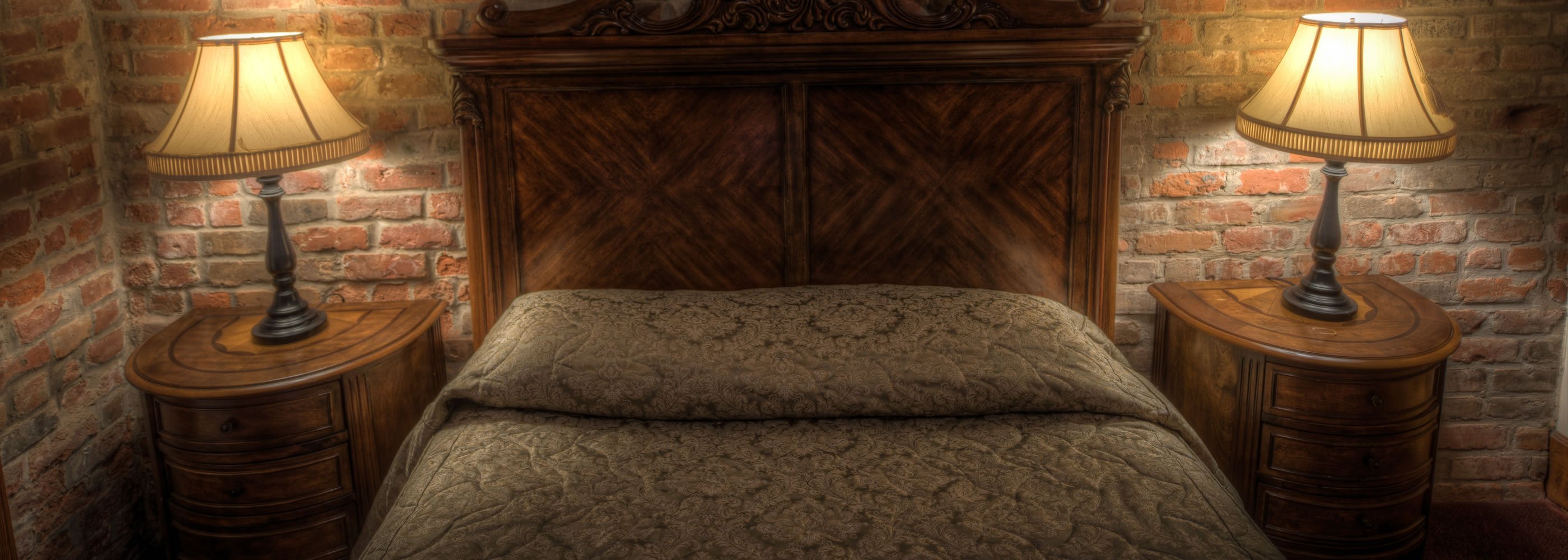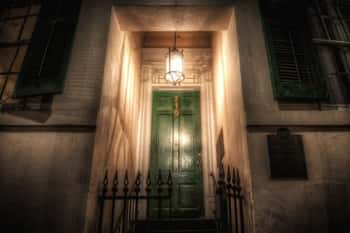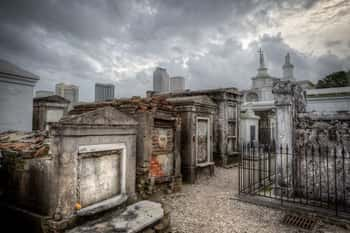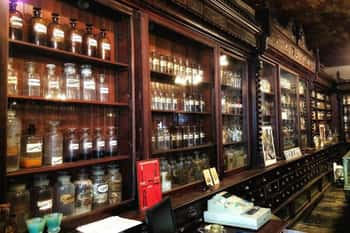
Just along the cusp of the French Quarter at 613 Esplanade Avenue sits a guest house with a mysterious origin and even more mysterious paranormal hauntings.
Known as the Jean Lafitte House, this guest house is considered to be one of the most haunted places to stay in all of New Orleans. But what exactly is going at this haunted hotel, and does the name really live up to its centuries-old past?
As the French Quarter was laid out in 1718 upon the arrival of the city’s founder, Jean Baptiste Le Moyne, Sieur Bienville, a portage—or ancient road—was needed for a quick passage from the Mississippi River to Lake Pontchartrain five miles upriver.
Esplanade Avenue became that necessary passage for the French colonists in the early eighteenth century. The ancient Native American portage stretched five miles, and it became the easiest possible route to bring goods from the river, through the connecting Bayou St. John to the Lake.
By the turn of the nineteenth century, Esplanade Avenue was starting to see the beginnings of a more residential area. And by the 1830s, it had gained even more notoriety as the city’s promenade publique, as it was one of the most sought after residential areas in the city. Nevertheless, the passageway was still used by sailors, merchants and, we can imagine, pirates too.
Allegedly, 613 Esplanade was once Jean Lafitte’s Captain’s Quarters, perhaps even for the equally as legendary Rene Baluche.
The history of pirates in New Orleans is a long-standing one. The French Crown was notorious for leaving its colonists to their own devises, and the colonists—well, they learned to fend for themselves. Smuggling and piracy became all too common within New Orleans, and it’s possible that Esplanade Avenue might have functioned as a smuggling route for black-trading merchants seeking to go north from the Mississippi River to Lake Pontchartrain.
Is it possible, then, that the infamous pirate Jean Lafitte and his fellow smugglers might once have used this thoroughway as well? According to the owner of the Jean Lafitte House, George, and the office manager, Jason, this seems to be the case. How do they know? Well, it comes down to a pool and a broken sewage pipe . . .
It was the year 1984, and George had ordered contractors to rip up the courtyard to put in a below-ground pool. In the area that was once informally referred to as “Frenchtown,” digging anything is sure to produce hidden mysteries or shocking finds.
In 2011, for example, a man on Burgundy Street was set on putting in a pool in his courtyard—it’s always the pools, y’all—and knew immediately to hire archaeologists before he began the project. He turned up with fifteen water-logged coffins dating to the eighteenth century.
Archaeology is sparse in the French Quarter and its surrounding neighborhoods, mainly because there has been too much city development. Unless a resident or business is doing construction to the outdoor space, or a building has fallen—as one did on Royal Street just a few years ago—there is not a single chance of getting your hands on any bit of history that might exist below the ground level surface.
But in 1984, George no doubt hadn’t expected to find anything at all. He was thinking about the comfort of the people who leased the timeshares at 613 Esplanade, now the Jean Lafitte House.
The construction company set to work, and along the back wall they discovered an underground tunnel running parallel with the guest house and with Esplanade Avenue itself.
Could it be true that the underground tunnel discovered by George and the construction workers was, in actuality, some sort of escape or smuggling passage for the pirates of early New Orleans? While we can’t prove for certain that Jean Lafitte or even his captain Rene Beluche lived at 613 Esplanade Avenue, the archaeological find is definitely a treasure all on its own, and it’s not even the last historical find that has been uncovered at the historic Jean Lafitte House.
It wasn’t until Jason, who started with George as the Jean Lafitte House’s main carpenter, was doing work on some of the rooms that the next piece of the puzzle slid into place . . .
For behind the plaster-covered walls were the building’s original beams. But those beams? They had their own story to tell.

In the early colonization period of New Orleans, it wasn’t all that uncommon for incomers to sail down the Mississippi River and realize that they had no hope of ever sailing against the current to return to wherever they had come from. Realizing that their options were limited, many sailors chose to disembark from their flat-wooden boats and sell the lumbar for quick cash. The boat wood was then re-manufactured into timber to build houses or whatever else the colonists might have required at the time, including banquettes or sidewalks.
(Further upriver from the French Quarter, in what it is now known as the Irish Channel, most of the homes bordering the Mississippi River are houses constructed from those discarded flatboats).
When Jason created peeled back the “awful plasterwork,” he unearthed old ship wood probably dated to the late eighteenth and early nineteenth centuries. Some still retained part of the bolts to hold the ship together, and most still had their original nails. The ceiling all on its own was a work of art, where the wooden beams appeared similarly to the ceilings onboard ships.
Once again, Jason and George were left to wonder what the house on 613 Esplanade must have been over a century ago.
Ship wood used to construct the home; a tunnel in the rear of the property; and then . . . and then there was more.
Jason was sitting in Unit 1 on the first floor, and he was moments away from drilling eight feet beneath the tiled floor in order to fix what he believed to be a broken sewage pipe. Little did he know that he was about see history with his own eyes.
For as deep as he dug—and the hole was only perhaps a foot-to-two feet in radius—Jason was quick to realize that he was passing through time.
“I was literally sitting in history,” he said with a gleeful smile. According to Jason, he hugged through at least five or six different roads within that eight-foot deep hole. He bypassed dirt roads, and other cement roads—the last was a cobble-stoned street.
“George would come back here and say, ‘are you done yet in there?’ and there I was sitting in this hole, sifting through history two hundred years ago. All I could tell him was that I’d be done soon!"
Turns out that for that particular day at work, Jason was more archaeologist than anything else. He pulled up old medicinal bottles, which still had the information for the druggist on there, as well as coins and other small objects.
It’s strange to think that street levels were much lower two hundred years ago, but it’s undoubtedly true. (For example, in Europe Roman or Iron Age excavations can have archaeologists ten to twelve feet beneath the earth’s current layer of soil).
Archaeology and paper documents are often meant to go hand-in-hand, but in the case of the Jean Lafitte House, it’s clear that more information exists from the property than in the city’s libraries or archival records.
And what’s good news? This property, which dates between 1813-1830s, will have the chance to reveal even more of its past in March 2016, when the pool in the courtyard is torn up and a new once built there instead.
(Don’t worry, I have already begged Jason to let me take part in the construction work, if only I can sit around with my trowel and hope my chance to do archaeology presents itself.)
It should come as no surprise that a building with so much history hidden behind its walls and beneath its surface should be reasonably haunted, as well.
So haunted, actually, that the most common question that the guest house’s staff are asked, is: “Is this place haunted?"
Simply enough: oh, yes it is.
Seen from the second floor on the property’s street-side building, a ghostly woman dressed in white has been seen in the corner room off from the main stairwell. Her spirit is known to huddle in the side room, which overlooks the courtyard; her features are indistinct and according to guests she doesn’t make a sound.
But the spirit is there.
In fact, Jason informed the Ghost City Team that he’d only just had two housekeeps up and quit. Both had worked at the Jean Lafitte House for approximately a year, and it wasn’t the first time that some of the employees of the guest house reported seeing spirits haunting the guest house’s corridors.
On that particular day, however, the housekeepers caught sight of the ghosty woman seated in the upstairs corner room and they’d had had enough. They came barging down the nineteenth-century circular staircase, and burst through the courtyard to find Jason in the office.
Out of breath with fright, they each told Jason that they were quitting and that there was nothing he could do to change their mind.
“They were really good employees,” Jason said, ambling down the same steps that the housekeepers used to flee just weeks prior. “But I guess seeing the ghost was just too much."
Other employees have remarked upon seeing the same otherworldly silhouette of the spirit, even though the spirit’s identity is unknown. If we had to guess, it’s likely that the ghostly woman was once a resident of the Jean Lafitte House before it became a guest house or timeshares.
Guests of the Jean Lafitte House have also reported hearing voices in the dead of the night.
When they approach Jason in the morning before leaving, their parting statements are always quite similar to one another: “Was there a party outside last night?"
Ghostly conversations and discussions seem so tangible and loud that guests have glanced out the windows of their suites, only to reason that there is not a single soul on the street.
A living soul, anyway.
At the Jean Lafitte house, the dead appear to be caught in the same commotion and busy-like nature that they might have experienced before the breath slipped from their bodies and their corporeal form was put to rest for eternity.
Is it possible that perhaps the disembodied voices heard at the Jean Lafitte House might even belong to the spirits of its alleged first residents, the pirates of New Orleans?
According to Jason, Unit 1 might be the most haunted ensuite in the entire guest house. (Unit 1 is also the location where Jason dug into the ground and unearthed all of those archaeological finds).
But paranormal story that sticks out among the rest centers around George, the owner of the property.
He’d had paperwork to do and decided at the table of Unit 1 to finish off the task. Papers were scattered across the tabletop, and George had poured himself as glass of water in case he felt thirsty, as well. He’d placed that in the center of the table for easy access.
He settled in. Read over same details for work; scratched out others. Then, he heard the soft screech of glass sliding over wood. He glanced up, only to see the glass of water as it stuttered across the table.
In shock, George could only watch. He wasn’t a believer in spirits, or in the paranormal whatsoever, but there was no hiding the fact that the glass was moving, skimming the surface of the table. It teetered then, on the edge of the table, before it felt to the ground and shattered into a million little pieces.
George wasted no time. He lurched from the table and hurried for the door.
The nonbeliever was quickly converted.
After the paranormal occurrence, George has passed most of the reins off to Jason to take care of at the Jean Lafitte House, while George himself spends most of his time at his other hotel, the Maison Pierre Lafitte on Roosevelt Way and Canal Street. Paranormal activity has been reported by guests and employees alike since that day when the glass was moved by some unseen force and pushed to the ground.
But who could possibly be haunting Unit 1? One can only hope that that question will be revealed when the Jean Lafitte House rips up the pool in the courtyard and has the chance to peer into the face of history one more time.
The Jean Lafitte House can best be described as staying in Old World New Orleans. and as Jason so appropriately put it: it is a bit like “staying in history,” too.
Composed of twelve ensuites, the Jean Lafitte House is perfect for people looking to be near the action of the bustling French Quarter but who also hope to have a bit of tranquility as well. Rooms tend to book up fast, especially from the end of September until the early Spring, so definitely reserve your rooms earlier rather than later! (Especially if you’re hoping for your own paranormal experience in the haunted Unit 1).
Interesting in learning more about staying at this historic guest house with traces of piracy and mysterious history thrown in? Follow this link to get all of the information you need to get started on your reservation process!

Ws this the site of a grizzly mass murder?

New Orleans' most haunted Cemetery

Who haunts this museum, and why?